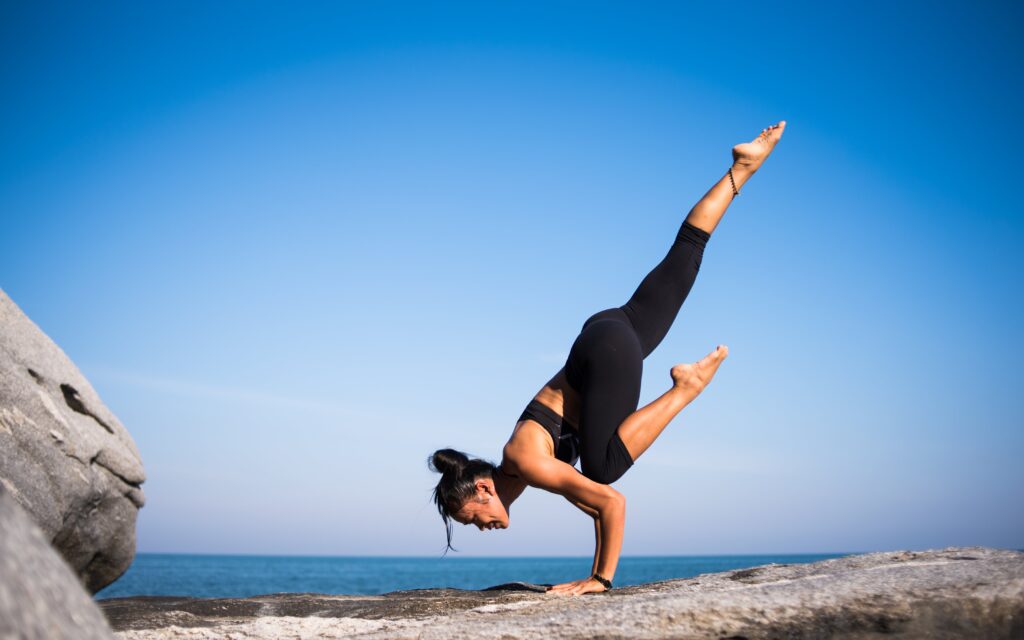
Flamingo Pose Yoga: Embrace Balance and Grace
Yoga, an ancient practice originating in India, encompasses a multitude of poses, each offering unique benefits for the mind, body, and soul. Among these is the elegant and graceful Flamingo Pose Yoga, which not only strengthens the body but also cultivates balance, flexibility, and mindfulness.
Introduction to Flamingo Pose Yoga
What is Flamingo Pose?
Flamingo Pose, also known as Utthita Padangusthasana in Sanskrit, is a standing yoga pose that mimics the stance of a flamingo, balancing on one leg while extending the other leg forward.
Origin and Significance of the Pose
The Flamingo Pose derives its name and inspiration from the majestic bird, the flamingo, known for its grace and poise. In yoga philosophy, balance represents harmony and equilibrium, making this pose symbolic of stability in both the physical and mental realms.
Benefits of Flamingo Pose Yoga
Physical Benefits
Flamingo Pose Yoga strengthens the legs, ankles, and core muscles, improving stability and posture. It also enhances hip flexibility and opens the chest, promoting better breathing and circulation.
Mental Benefits
Performing Flamingo Pose requires focus and concentration, helping to calm the mind and alleviate stress. It encourages mental clarity and presence, fostering a sense of inner peace and tranquility.
Emotional Benefits
The graceful nature of Flamingo Pose instills feelings of confidence and self-assurance. It encourages practitioners to embrace their inner elegance and grace, fostering a positive body image and self-esteem.
How to Perform Flamingo Pose
To practice Flamingo Pose:
- Begin in Mountain Pose (Tadasana), standing tall with feet hip-width apart.
- Shift your weight onto your left foot and lift your right foot off the ground.
- Reach down and clasp the big toe of your right foot with your right hand.
- Extend your right leg forward, keeping it straight, and engage your core.
- Find your balance and lengthen your spine, reaching the crown of your head towards the sky.
- Hold the pose for 30 seconds to 1 minute, then switch sides.
Modifications for Beginners
If you’re new to Flamingo Pose, you can use a wall or chair for support. Focus on maintaining proper alignment and gradually work towards extending your leg without assistance.
Precautions and Tips
While practicing Flamingo Pose, it’s essential to:
- Avoid locking your standing knee to prevent injury.
- Keep your hips level and square to the front.
- Maintain a steady gaze to help with balance.
- Listen to your body and respect its limits, avoiding any pain or discomfort.
Variations of Flamingo Pose
Flamingo Pose Yoga offers several variations to suit different skill levels and needs:
- Advanced variations include binding the extended leg behind the head or transitioning into a handstand.
- Variations for specific needs include using a strap to reach the toe or practicing against a wall for stability.
Flamingo Pose and Balance
Importance of Balance in Yoga
Balance is a fundamental aspect of yoga, representing the equilibrium between strength and flexibility, effort and ease, stability and mobility.
How Flamingo Pose Enhances Balance
Flamingo Pose challenges your balance by requiring you to stand on one leg while extending the other leg forward. By engaging the core and focusing your gaze, you cultivate steadiness and poise, both on and off the mat.
Flamingo Pose in Yoga Sequences
Incorporating Flamingo Pose into your yoga practice can add variety and challenge. Try integrating it into sequences such as Sun Salutations or standing balance flows for a full-body workout.
Sample Yoga Sequences
- Warm-Up Sequence:
- Mountain Pose (Tadasana)
- Tree Pose (Vrksasana)
- Flamingo Pose (Utthita Padangusthasana)
- Balance Flow:
- Warrior II (Virabhadrasana II)
- Extended Side Angle Pose (Utthita Parsvakonasana)
- Half Moon Pose (Ardha Chandrasana)
- Flamingo Pose (Utthita Padangusthasana)
Flamingo Pose and Mindfulness
Connecting with Nature
Flamingo Pose invites you to connect with the natural world, mirroring the grace and beauty of the flamingo in its habitat. By embodying the essence of this majestic bird, you tap into a deeper sense of awareness and appreciation for the environment around you.
Mindfulness Practices during the Pose
While in Flamingo Pose Yoga, focus on your breath and the sensations in your body. Notice the subtle shifts in balance and stability, remaining present and attentive to the present moment. Embrace the stillness and tranquility that arise, allowing yourself to be fully immersed in the experience.
Flamingo Pose for Flexibility
Stretching Benefits
Flamingo Pose elongates the hamstrings, calves, and hip flexors, promoting greater flexibility and range of motion in the lower body. It also stretches the shoulders and chest, releasing tension and tightness in the upper body.
Flexibility Exercises
To enhance flexibility in Flamingo Pose, incorporate dynamic stretches such as leg swings and hip circles into your warm-up routine. Practice regular yoga poses like Forward Fold (Uttanasana) and Downward-Facing Dog (Adho Mukha Svanasana) to improve overall flexibility.
Flamingo Pose for Strength
Muscles Engaged during the Pose
Flamingo Pose strengthens the muscles of the standing leg, including the quadriceps, glutes, and calves. It also engages the core muscles to maintain stability and balance throughout the pose.
Building Strength through Flamingo Pose
To build strength in Flamingo Pose Yoga, focus on grounding through the standing foot and engaging the thigh muscles. Lift and extend the extended leg actively, maintaining integrity in the pose. Incorporate variations and transitions to challenge yourself and progress in your practice.
Flamingo Pose for Stress Relief
Relaxation Techniques
Flamingo Pose offers a sense of release and relaxation, allowing tension and stress to melt away. Focus on deep, rhythmic breathing to calm the nervous system and quiet the mind. Visualize yourself as a graceful flamingo, embodying serenity and tranquility.
Stress-Relieving Benefits of the Pose
By practicing Flamingo Pose regularly, you can reduce stress and anxiety levels, promoting a sense of inner peace and well-being. The gentle stretching and balancing aspects of the pose soothe the body and mind, creating a space for relaxation and rejuvenation.
Common Challenges and Solutions
Overcoming Difficulties in the Pose
Common challenges in Flamingo Pose include loss of balance, tightness in the hamstrings, and difficulty reaching the extended foot. To overcome these difficulties, focus on stabilizing through the standing leg and using props or modifications as needed.
Solutions for Common Challenges
- Use a yoga block or strap to reach the extended foot if flexibility is limited.
- Practice near a wall or sturdy surface for support and stability.
- Work on strengthening the muscles of the standing leg through targeted exercises such as lunges and squats.
Flamingo Pose and Body Awareness
Body Awareness Exercises
Flamingo Pose Yoga cultivates body awareness by requiring you to tune into subtle sensations and movements. Pay attention to the alignment of your joints, the activation of your muscles, and the distribution of weight in the pose.
Enhancing Proprioception through the Pose
Proprioception, or the awareness of your body in space, is enhanced through Flamingo Pose as you refine your sense of balance and coordination. Practice the pose mindfully, focusing on the feedback from your body and making adjustments as needed to find optimal alignment.
Flamingo Pose for Grounding
Connecting with the Earth
Flamingo Pose encourages you to root down through the standing foot, connecting with the earth beneath you. Visualize roots extending from your foot into the ground, anchoring you firmly and providing stability and support.
Grounding Techniques during the Pose
To deepen your sense of grounding in Flamingo Pose, focus on pressing evenly through the entire sole of the standing foot. Engage the muscles of the leg and activate the arch of the foot to create a stable foundation. Draw energy up from the earth through the body, feeling rooted and grounded in the present moment.
Conclusion
Flamingo Pose Yoga offers a blend of strength, balance, flexibility, and mindfulness, making it a valuable addition to any yoga practice. By embracing the elegance and grace of the flamingo, practitioners can cultivate a deeper connection to their bodies, minds, and the natural world around them. Whether you’re seeking physical fitness, mental clarity, or emotional well-being, Flamingo Pose provides a pathway to greater harmony and vitality.
FAQs (Frequently Asked Questions)
- Is Flamingo Pose suitable for beginners?
- Yes, Flamingo Pose can be modified to suit beginners by using props or practicing near a wall for support.
- How long should I hold Flamingo Pose?
- Aim to hold Flamingo Pose for 30 seconds to 1 minute on each side, gradually increasing the duration as you build strength and stability.
- Can Flamingo Pose help with balance issues?
- Yes, practicing Flamingo Pose regularly can improve balance and stability by strengthening the muscles of the legs and core.
- Are there any contraindications for Flamingo Pose?
- Individuals with ankle, knee, or hip injuries should avoid Flamingo Pose or practice under the guidance of a qualified yoga instructor.
- How often should I practice Flamingo Pose?
- You can practice Flamingo Pose as part of your regular yoga routine, aiming for at least 3-4 times per week to experience its full benefits.





Leave Your Comment